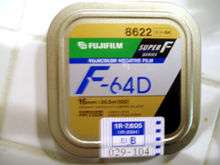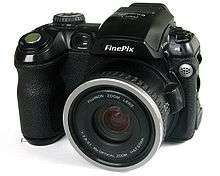Fujifilm
|
Value from Innovation | |
|
Midtown West, the current global headquarters of Fujifilm in Tokyo. | |
| Public | |
| Traded as |
TYO: 4901 TOPIX Large 70 Component |
| Industry |
Document solutions Digital imaging Medical imaging Cosmetics |
| Founded | January 20, 1934 |
| Headquarters |
Midtown West, Tokyo Midtown Akasaka, Minato, Tokyo, Japan |
Area served | Worldwide |
Key people |
Shigetaka Komori (Chairman and CEO) Shigehiro Nakajima (President and COO) |
| Products | Digital imaging and photographic materials, equipment and services, cosmetics |
| Revenue | ¥ 2492.6 billion (2015)[1] |
| ¥ 137.1 billion (¥118.6 attributable to FUJIFILM Holdings) (2015)[1] | |
Number of employees | 79,235 (consolidated, as of March 31, 2015)[1] |
| Website | www.fujifilm.com |
Fujifilm Holdings Corporation, (富士フイルム株式会社 Fujifuirumu Kabushiki-kaisha), better known as Fujifilm or simply Fuji, stylized as FUJiFILM, is a Japanese multinational photography and imaging company headquartered in Tokyo.
Fujifilm's principal activities are the development, production, sale and servicing of business document solutions, medical imaging and diagnostics equipment, cosmetics, optical films for flat panel displays, optical devices, photocopiers and printers, digital cameras, color film, color paper, photofinishing equipment, photofinishing chemicals, graphic arts equipment and materials.
History
20th century
Fuji Photo Film Co., Ltd. was established in 1934 with the aim of being the first Japanese producer of photographic films. Over the following 10 years, the company produced photographic films, motion-picture films and X-ray films. In the 1940s, Fuji Photo entered the optical glasses, lenses and equipment markets. After the Second World War, Fuji Photo diversified, penetrating the medical (X-ray diagnosis), printing, electronic imaging and magnetic materials fields. In 1962, Fuji Photo and U.K.-based Rank Xerox Limited (now Xerox Limited) launched Fuji Xerox Co., Ltd. through a joint venture.
From the mid-1950s, Fuji Photo accelerated the establishment of overseas sales bases. In the 1980s, Fuji Photo expanded its production and other bases overseas, stepping up the pace of its business globalization. Meanwhile, Fuji Photo developed digital technologies for its photo-related, medical and printing businesses.
Like its rival Eastman Kodak which dominated in the US, Fuji Photo enjoyed a longtime near-monopoly on camera film in Japan. By becoming one of the title sponsors of the 1984 Los Angeles Olympics (an opportunity that Kodak passed on), offering cheaper camera film, and establishing a film factory in the US, Fuji gained considerable market share there, while Kodak had little success in penetrating Japan. In May 1995, Kodak filed a petition with the US Commerce Department under section 301 of the Commerce Act arguing that its poor performance in the Japanese market was a direct result of unfair practices adopted by Fuji. The complaint was lodged by the US with the World Trade Organization. On January 30, 1998, the WTO announced a "sweeping rejection of Kodak's complaints" about the film market in Japan.[2][3]
21st century
The new millennium witnessed the rapid spread of digital technology in cameras. Demand for photographic films plunged in line with the growing popularity of digital cameras. In response, Fuji Photo implemented management reforms aimed at effecting drastic transformation of its business structures. Even as early as the 1980s, the company had foreseen the switch from film to digital, so "it developed a three-pronged strategy: to squeeze as much money out of the film business as possible, to prepare for the switch to digital and to develop new business lines." While both film manufacturers recognized this fundamental change, Fuji Photo adapted to this shift much more successfully[2] than Eastman Kodak (which filed for bankruptcy in January 2012). Fuji Photo's diversification efforts also succeeded while Kodak's had failed; furthermore Kodak built up a large but barely profitable digital camera business that was undone quickly by smartphone cameras.[2]
In September 19, 2006, Fujifilm announced[4] plans to establish a holding company, Fujifilm Holdings Corp. Fujifilm and Fuji Xerox would become subsidiaries of the holding company. A representative of the company reconfirmed its commitment to film, which accounts for 3% of sales.[5]
Subsidiaries
Fuji Xerox is a joint venture between Fujifilm and Xerox Corporation of North America. Fujifilm bought Sericol Ltd., a UK-based printing ink company specializing in screen, narrow web, and digital print technologies in March 2005.[6]
Fujifilm de México is a Fujifilm subsidiary in Mexico that sells Fujifilm products since 1934 and has been recognized as one of The Best Mexican Companies (Las Mejores Empresas Mexicanas) from 2012 to 2015, a recognition promoted by Banamex, Deloitte México and Tecnológico de Monterrey.[7]
Company interrelation
- Fujifilm Holdings
- Fujifilm
- Fujifilm Imaging Systems
- Fujifilm Medical
- Fujifilm Pharma
- Fujifilm RI Pharma
- Fujifilm Photo Manufacturing
- Fujifilm Fine Chemicals
- Fujifilm Electronics Materials
- Fujifilm Engineering
- Fujifilm Optics
- Fujifilm Opto Materials
- Fujifilm Global Graphic Systems
- Fujifilm Computer Systems
- Fujifilm Software
- Fujifilm Techno Services
- Fujifilm Techno Products
- Fujifilm Business Supply
- Fujifilm Digital Press
- Fujifilm Media Crest
- Fujifilm Sonosite, Inc.
- Fujifilm Shizuoka
- Fujifilm Kyushu
- Fujifilm Logistics
- Fuji Xerox
- Fuji Xerox Printing Systems Sales
- Fuji Xerox Information Systems
- Fuji Xerox System Service
- Fuji Xerox Interfield
- Fuji Xerox Advanced Technologies
- Fuji Xerox Manufacturing
- Fuji Xerox Service Creative
- Fuji Xerox Service Link
- Fuji Xerox Learning Institute
- Toyama Chemical
- Taisho Toyama Pharmaceutical
- Fujifilm Business Expert
- Fujifilm
Products






Photographic film
- Fujifilm photographic films
- Motion picture film stock.
- Fujichrome color reversal (slide) films.
- Velvia: one of the most saturated and fine-grained slide films, valued by nature and landscape photographers.
- Provia: a slide film giving more natural colors than Velvia
- Astia: a fined grained, low contrast slide film often used for studio or portrait applications
- Sensia: a low-contrast consumer slide film; the current emulsion is considered to be identical or near-identical to Astia in the professional line.[8][9]
- Fortia: consumer slide film, featuring extremely vivid color rendering suitable for flower photography and other high-saturation applications (for Japanese market).
- Fujicolor color negative (print) films
- Fujicolor Pro 160S, 160C, 400H, and 800Z (formerly NPS, NPC, NPH, and NPZ): professional films with different levels of contrast
- Reala: the first film to use the fourth cyan-sensitive layer, currently sold under Superia Reala name
- Superia: intended for snapshots
- Press: Cut from the same emulsion stock as Superia, but cold stored and sold as a professional film.
- Fuji Neopan Professional black & white negative film. As a side note, Neopan 400 and 1600 were designed to use the same developing times, and can be developed in the same tank/machine and developer combination simultaneously. ACROS and SS do not share this feature.
- Neopan SS: ISO 100 film, most common and least expensive Neopan film
- Neopan ACROS: ISO 100 film, finer grain than SS but usually more expensive
- Neopan Presto: ISO 400 speed film
- Neopan Super Presto: ISO 1600 for low-light shooting or fast action
Cameras and lenses
- The Fujifilm FinePix series of digital cameras including:
- Fujifilm X-mount compatible Mirrorless interchangeable-lens cameras like the X-Pro1, X-A1 etc.
- Nikon F-mount compatible digital SLRs like the FinePix S5 Pro
- Compact cameras like the FinePix F-series and FinePix Z-Series, Fujifilm X100 and X100S
- Waterproof and shockproof FinePix XP-Series digital cameras
- The Fujifilm GFX 50S, medium format digital, announced in 2016. This uses the Fuji G-mount lenses, to be released in 2017
- The Clear Shot series of 35mm compact cameras
- Instax series of instant camera
- Fotorama series of instant camera
- Various rangefinder cameras, and older Fujica film cameras
- Professional film cameras such as the GA645,[10] GW670, GW690, GF670, GF670W and Fuji GX680 6x8cm medium format cameras
- Fujinon camera lenses and binoculars: including the most widely used television lenses in the world
Other
.jpg)
- Photographic paper
- Inkjet printer paper
- Magnetic media, including audiotape (also includes the Axia brand) until 2009, videotape, Magnetic tape data storage and floppy disks
- Optical media, such as DVDs and CDs, mostly produced by Ritek and Taiyo Yuden; some by Philips
- Flash memory
- Photostimulable Phosphor Plate - X-ray film.
- Base material for LCD displays
- instax: Fuji instant film packs and backs for sheet film cameras
- Microfilm
- Minilab equipments, announced in 2006 a global alliance with Noritsu Koki, together holding a market share of more than 80% of the global market
- Digital X-Ray, digital mammography and computed radiography devices
- Synapse Radiology PACS
- Synapse Cardiovascular PACS
- Synapse RIS
- Cosmetics (ASTALIFT series, Nanolift series)
See also
References
- 1 2 3 "Fujifilm Annual Report 2010" (PDF). Fujifilm Holdings Corporation. pp. 6–7. Retrieved 2016-05-10.
- 1 2 3 "Technological change: The last Kodak moment?". The Economist. 2012-01-14. Retrieved 2014-02-07.
- ↑ "The Kodak - Fuji Rivalry |Business Strategy Case Studies|Business Strategy Articles". Icmrindia.org. 2013-11-14. Retrieved 2014-02-07.
- ↑ New Management Structure for Fujifilm Group Starts on October 1
- ↑ Fuji Photo to diversify, shift to holding company system | The Japan Times Online
- ↑ Fuji Photo Film Acquires Sericol Group of the United Kingdom
- ↑ "Empresas Reconocidas - Las Mejores Empresas Mexicanas". Mejoresempresasmexicanas.com. Retrieved 2016-06-13.
- ↑ Everything but the kitchen sink
- ↑ "Fuji Astia 100F Slide Film Review". Nathangriffin.com. Retrieved 2014-02-07.
- ↑ "Awards:GOOD DESIGN | 富士フイルムのデザイン". design.fujifilm.com. Retrieved 2015-12-29.
External links
| Wikimedia Commons has media related to Fujifilm. |
- Official Online Store
- "Company history books (Shashi)". Shashi Interest Group. April 2016. Wiki collection of bibliographic works on Fujifilm
| |||||||||||||||||||||||||||||||||||||||||||||||||||||||||||||||||||||||||||||||||||||||||||||||||||||||||||||||||||||||||||||||||||||||||||||||||||||||||||||||||||||||||||||||||||||||||||||||||||||||||||||||||||||||||||||||||||||||||||||||||||||||||||||||||||||||||||||||||||||||||||||||||||||||||||||||||||||||||||||||||||